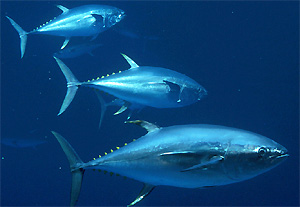- Yellowfin tuna
Taxobox
name = Yellowfin tuna
status = LR/lc | status_system = IUCN2.3

image_width = 200px
regnum =Animal ia
phylum = Chordata
classis =Actinopterygii
ordo =Perciformes
familia =Scombridae
genus = "Thunnus "
species = "T. albacares"
range_
range_map_caption=
binomial = "Thunnus albacares"
binomial_authority = Bonnaterre, 1788The yellowfin tuna ("Thunnus albacares"), is a type oftuna . It is found in open waters oftropical and subtropicalsea s worldwide. It is an epipelagic fish ranging in the top 100 m (330 feet) of the water column. Reported sizes have ranged as high as 239 cm (94 inches) in length and 200 kg (440 lb) in weight. Also known as ahi tuna, from its Hawaiian name okinaahi, yellowfin is becoming a popular replacement for the severely depleted supplies ofbluefin tuna .The second
dorsal fin and theanal fin are both bright yellow, thus the common name, and can be very long in mature specimens, as are thepectoral fin s. The main body is very dark metallic blue, changing to silver on the belly, which has about 20 vertical lines.Yellowfins tend to school with fishes of the same size, including other species of tuna, and larger fish are often seen with
dolphin s,porpoise s,whale s andwhale shark s. Yellowfins eat other fish,crustacean s, andsquid .Commerce
Commercial fisheries catch yellowfin tuna with
encircling net s (purse seines) and with longlines. The fish are mainly sold in frozen or canned form, but are also popular assashimi .port and food
in many parts of their range and are prized for their speed and strength when fought on rod and reel as well as for their table qualities. Shane Boland holds the record for the biggest tuna caught.
Culinary uses
According to the Hawaii Seafood Buyers Guide 'Yellowfin tuna is widely used as raw fish dishes, especially
sashimi . This fish is also excellent for grilling. [ [http://www.hawaii-seafood.org/yellowfin.html?ref=Hawaii Seafood Buyers Guide ] ] Yellowfin is often served seared or rare.Yellowfin buyers often recognize two grades, "Sashimi grade" and "other", although there are variations in the quality of "other" grades. [ [http://www.hawaii-seafood.org/yellowfin.html?ref=Hawaii Seafood Buyers Guide] ]
In terms of whether the yellowfin tuna fishing industry is sustainable, the jury is out. The Audobon's Seafood Guide (a guide for what types of marine food products are not eco-friendly) lists yellowfin tuna that have been troll-caught as "OK" but those that have been long-line caught as "Be Careful" ( [ [http://seafood.audubon.org] ]
References
* Listed as Least Concern (v2.3).
*
Wikimedia Foundation. 2010.
